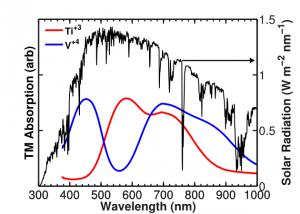Glass-based Luminescent Solar Concentrator
- Category: Energy
- Tags: Harry Tuller, Marc Baldo, Nicholas Thompson, Philip Reusswig
Photovoltaic solar concentrators aim to increase the electrical power obtained from solar cells. Conventional solar concentrators track the sun to generate high optical intensities, often by using large mobile mirrors that are expensive to deploy and maintain. High optical concentrations without excess heating in a stationary system can be achieved with a luminescent solar concentrator (LSC) [1] . The LSC consists of a dye dispersed in a transparent waveguide. Incident light is absorbed by the dye and then reemitted into a waveguide mode. The energy difference between absorption and emission prevents reabsorption of light by the dye, isolating the photon population in the waveguide. The performance of LSCs has been limited by two factors: self-absorption losses and a scarcity of dyes that emit efficiently in the infrared region. We have previously made significant progress on the problem of self-absorption losses [2] . Now we address operation in the infrared region.
Neodymium (Nd3+) and ytterbium (Yb3+) are nearly the optimal infrared LSC materials: inexpensive, abundant, efficient, and spectrally well-matched to high-performance silicon solar cells. These rare earth ions are natural three or four-level systems, therefore reasonably transparent to their own radiation and capable of generating high optical concentrations. Neodymium’s and ytterbium’s disadvantage is their relatively poor absorption overlap with the visible spectrum, meaning that the rare earth ions will require sensitization in the visible spectrum. Transition metals (TMs) can efficiently transfer energy to Nd and Yb ions, a process depicted in Figure 1. With a selection of TMs, broad sensitization of the both the visible and near infrared regions of the solar spectrum is possible, as shown in Figure 2. Finally, these ions can be combined with a high-throughput and chemically robust glass-making process for low cost and stable LSCs. Sensitized neodymium and ytterbium should enable LSCs matched to silicon.
- Figure 1: A schematic representation of an LSC. The LSC consists of transition metal (TM) and rare earth (RE) ion-doped glass and a diffuse back reflector. Solar radiation incident on the LSC is primarily absorbed by the TM ion and transferred to the RE ion via non-radiative energy transfer (represented by the blue arrow), the RE then emits the light that is waveguided to the edges.
- Figure 2: A comparison between the solar spectrum (black) and the absorption of several transition metal ions (blue and red). The broadband absorption of the TMs will utilize a large portion of the solar spectrum, including previously under-utilized portions of the near-infrared.
- W. H. Weber and J. Lambe, “Luminescent greenhouse collector for solar radiation,” Applied Optics, vol. 15, no. 10, pp. 2299-2300, Oct. 1976. [↩]
- M. J. Currie, J. K. Mapel, T. D. Heidel, S. Goffri, and M. A. Baldo, “High-efficiency organic solar concentrators for photovoltaics,” Science, vol. 321, no. 5886, pp. 226 -228, July 2008. [↩]

